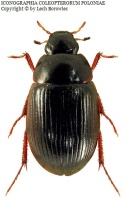Підтримуємо Вільну Україну
 We Support Free Ukraine
We Support Free Ukraine

Biodiversity Map
Taxa

Hydrobius — subordinate taxa:
Taxon count: 2
-
Arthropodaphylum
Click to switch
to select orders
and filters > -
Hexapodasubphylum
Click to switch
to select orders
and filters > -
Insectaclass
Click to switch
to select orders
and filters > -
Coleopteraorder
Click to set
as the main taxon
and as a base
← of the left panel > -
Polyphagasuborder
Click to set
as the main taxon
and as a base
← of the left panel > -
Staphyliniformiaseries
Click to set
as the main taxon
and as a base
← of the left panel > -
Hydrophiloideasuperfamily
Click to set
as the main taxon
and as a base
← of the left panel > -
Hydrophilidaefamily
Click to set
as the main taxon
and as a base
← of the left panel > -
Hydrophilinaesubfamily
Click to set
as the main taxon
and as a base
← of the left panel > -
Hydrophilinitribe
Click to set
as the main taxon
and as a base
← of the left panel > -
Hydrobiusinasubtribe
Click to set
as the main taxon
and as a base
← of the left panel > -
Hydrobiusgenus
Click to set
as the main taxon
and as a base
← of the left panel >
PL
YES
name status: valid name
BioMap ID: 1004636
taxon code: 783+784+785
taxonomy checked: YES
Data on distribution in Poland

Statistics
- Records: 330
- Publications: 136
- Collections: 10
- Publication authors: 118
- Illustrations (iconography): 2
- Photos (specimen/observation): 2
Taxon description
[KFP 783: Hydrobius fuscipes] Gatunek notowany powszechnie z całej Palearktyki, wykazany również z Ameryki Północnej. Występuje w różnego rodzaju nie zacienionych zbiornikach wodnych. Żyje zarówno w wodach słodkich jak i słonych.
[KFP 785: Hydrobius subrotundus] Rozmieszczenie tego gatunku jest słabo poznane, gdyż dopiero niedawno udowodniono, że mylono go powszechnie z gatunkiem Hydrobius fuscipes (L.). Stwierdzony dotychczas w środkowej Europie, Fennoskandii i na Wyspach Brytyjskich. Znajdowany w zacienionych, leśnych zbiornikach wodnych i na torfowiskach.
[KFP 784: Hydrobius rottenbergii] Gatunek o niedostatecznie poznanym rozmieszczeniu, gdyż do niedawna uważany za odmianę Hydrobius fuscipes (L.), wobec czego niektóre z danych rozmieszczeniowych tego gatunku mogą się odnosić do Hydrobius rottenbergii Gerhardt. Warunki ekologiczne mało znane. W Szwecji notowany tylko z południowych wybrzeży morskich, gdzie występuje tylko w strefie rozprysku wody. Z uwagi na wymienione środowisko, z jakim prawdopodobnie jest omawiany gatunek związany, dane z naszego kraju, prócz Pobrzeża Bałtyku, wymagają dalszych, dokładniejszych badań.
External data sources
- Ostatnie rekordy
-
1104865
 ⊡
⊡ Hydrophilidae: Hydrobius fuscipes, PL, Nizina Mazowiecka, Sikórz, UTM DD03 (Abraszewska-Kowalczyk et Kowalczyk 2002)
Hydrophilidae: Hydrobius fuscipes, PL, Nizina Mazowiecka, Sikórz, UTM DD03 (Abraszewska-Kowalczyk et Kowalczyk 2002) -
1058433
 ⊡
⊡ Hydrophilidae: Hydrobius fuscipes, PL, Nizina Mazowiecka, Wilga, UTM EC24, 1993, leg. J. Siekierski
Hydrophilidae: Hydrobius fuscipes, PL, Nizina Mazowiecka, Wilga, UTM EC24, 1993, leg. J. Siekierski -
1058301
 ⊡
⊡ Hydrophilidae: Hydrobius fuscipes, PL, Nizina Mazowiecka, Wilga, UTM EC24, 1993, leg. J. Siekierski
Hydrophilidae: Hydrobius fuscipes, PL, Nizina Mazowiecka, Wilga, UTM EC24, 1993, leg. J. Siekierski -
1058300
 ⊡
⊡ Hydrophilidae: Hydrobius fuscipes, PL, Nizina Mazowiecka, Wilga, UTM EC24, 1993, leg. J. Siekierski
Hydrophilidae: Hydrobius fuscipes, PL, Nizina Mazowiecka, Wilga, UTM EC24, 1993, leg. J. Siekierski -
1058299
 ⊡
⊡ Hydrophilidae: Hydrobius fuscipes, PL, Nizina Mazowiecka, Wilga, UTM EC24, 1993, leg. J. Siekierski
Hydrophilidae: Hydrobius fuscipes, PL, Nizina Mazowiecka, Wilga, UTM EC24, 1993, leg. J. Siekierski -
888747
 ×
× Hydrophilidae: Hydrobius fuscipes, PL (Przewoźny et Mazur 2007)
Hydrophilidae: Hydrobius fuscipes, PL (Przewoźny et Mazur 2007) -
808404
 ⊡
⊡ Hydrophilidae: Hydrobius fuscipes, PL, Tatry, Tatry Wysokie, Dolina Rybiego Potoku, UTM DV35, 2007, leg. T. Wojas (Wojas 2010a)
Hydrophilidae: Hydrobius fuscipes, PL, Tatry, Tatry Wysokie, Dolina Rybiego Potoku, UTM DV35, 2007, leg. T. Wojas (Wojas 2010a) -
773077
 ○
○ Hydrophilidae: Hydrobius fuscipes, PL, Puszcza Białowieska, Białowieski P.N., UTM FD94, 1991, leg. L. Borowiec, coll. Uniw. Wrocławski, ZBiTE
Hydrophilidae: Hydrobius fuscipes, PL, Puszcza Białowieska, Białowieski P.N., UTM FD94, 1991, leg. L. Borowiec, coll. Uniw. Wrocławski, ZBiTE -
772673
 ⊡
⊡ Hydrophilidae: Hydrobius fuscipes, PL, Pobrzeże Bałtyku, Dąbki ad Koszalin, UTM WA82, 1991, leg. J. Kania, coll. Uniw. Wrocławski, ZBiTE
Hydrophilidae: Hydrobius fuscipes, PL, Pobrzeże Bałtyku, Dąbki ad Koszalin, UTM WA82, 1991, leg. J. Kania, coll. Uniw. Wrocławski, ZBiTE -
772102
 ⊡
⊡ Hydrophilidae: Hydrobius fuscipes, PL, Dolny Śląsk, Kotowice ad Oława, UTM XS55, 1990, leg. L. Borowiec, coll. Uniw. Wrocławski, ZBiTE
Hydrophilidae: Hydrobius fuscipes, PL, Dolny Śląsk, Kotowice ad Oława, UTM XS55, 1990, leg. L. Borowiec, coll. Uniw. Wrocławski, ZBiTE - ... more
- Powiązane publikacje
-
Wojas T. 2010a. Materiały do poznania chrząszczy (Insecta: Coleoptera) torfowisk i młak Tatr Polskich. Parki Nar. Rez. Przyr., 29(3):49-75.
 Show records
Show records -
Greń Cz. 2010. Chrząszcze wodne (Coleoptera: Noteridae, Dytiscidae, Haliplidae, Gyrinidae, Hydrophilidae) rezerwatu „Ochojec” w Katowicach. [In:] Parusel J.B. (Ed.) Rezerwat przyrody „Ochojec” w Katowicach (Górny Śląsk). Monografia naukowo-dydaktyczna. Centrum Dziedzictwa Przyrody Górnego Śląska, Katowice. pp. 171-173.
 Show records
Show records -
Ruta R. 2009b. Chrząszcze (Insecta: Coleoptera) Rynny Jezior Kuźnickich ze szczególnym uwzględnieniem rezerwatu „Kuźnik”. [In:] Owsianny P.M. (Ed.) Rynna Jezior Kuźnickich i rezerwat przyrody „Kuźnik” – Bioróżnorodność, Funkcjonowanie, Ochrona i Edukacja. Muzeum Stanisława Staszica, Piła. pp. 150-177.
 Show records
Show records -
Jaskuła R., Przewoźny M., Melke A. 2009a. Chrząszcze (Coleoptera). [In:] Jaskuła R., Tończyk G. (Eds.) Owady (Insecta) Spalskiego Parku Krajobrazowego, Część I. Mazowiecko-Świętokrzyskie Towarzystwo Ornitologiczne, Spała. pp. 27-59.
 Show records
Show records -
Greń Cz. 2009a. Chrząszcze wodne (Coleoptera: Dytiscidae, Haliplidae, Hydrophilidae, Elmidae) obszaru źródliskowego Wisły w rezerwacie przyrody „Barania Góra“ (Beskid Śląski). Acta Ent. Siles., 17:41-52.
 Show records
Show records - ... more










